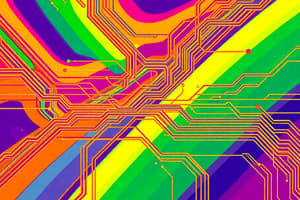Podcast
Questions and Answers
What does the term ----- ----- ----- in HDL synthesis?
What does the term ----- ----- ----- in HDL synthesis?
- A high-level description of the design
- A simulation of the hardware behaviour
- List of logic gates and their connections (correct)
- A block diagram of the circuit
Which of the following is NOT a step in the HDL design flow?
Which of the following is NOT a step in the HDL design flow?
- RTL Design
- Synthesis
- Place and Route
- Physical Layout Design (correct)
Why is Timing analysis crucial in HDL design?
Why is Timing analysis crucial in HDL design?
- To ensure that all timing constraints like clock speed and signal delays are met. (correct)
- To check the physical size of the circuit
- To verify the transistor-level design
- To reduce the complexity of synthesis
What is the purpose of synthesis in HDL design?
What is the purpose of synthesis in HDL design?
What does RTL design focus on in HDL design flow?
What does RTL design focus on in HDL design flow?
What is the first step in the HDL design flow?
What is the first step in the HDL design flow?
RTL in RTL Design stands for:
RTL in RTL Design stands for:
In the HDL design flow, the Verification is important because it;
In the HDL design flow, the Verification is important because it;
Which step ensures that the design can meet the desired clock speed?
Which step ensures that the design can meet the desired clock speed?
How does HDL improve the design cycle over manual design methods?
How does HDL improve the design cycle over manual design methods?
Flashcards are hidden until you start studying
Study Notes
HDL Synthesis
- Synthesis converts HDL code into a netlist, which is an abstract representation of the hardware design.
- The netlist describes the interconnection of logic gates and other hardware components.
- Synthesis tools analyze the HDL code and choose the optimal implementation for the specified target technology.
HDL Design Flow Steps
- Design Entry: This is the first step where the designer writes the HDL code, describing the functionality of the circuit.
- Synthesis: Translates the HDL code into a hardware description.
- Functional Simulation: This step verifies the logical functionality of the design.
- Timing Analysis: Ensures the design meets the desired speed requirements and timing constraints.
- Place and Route: This stage physically implements the design on the target device, assigning locations to components and routing interconnections.
- Physical Verification: Verifies the physical design, ensuring it meets the layout constraints.
- Implementation: This step involves generating the final output files, such as the netlist, to be used for manufacturing the hardware device.
Importance of Timing Analysis
- Critical to ensure that the design can operate at the desired speed.
- Analyzes the timing constraints of the design, like clock speeds and signal propagation delays, to identify potential timing violations.
- Ensures stable and reliable operation of the circuit.
Purpose of Synthesis in HDL Design
- Bridges the gap between the abstract design described in HDL and the physical implementation.
- Converts the HDL code into a low-level representation that can be understood by fabrication tools.
- Optimizes the design for resource utilization, performance, and area.
Focus of RTL Design
- Register-Transfer Level (RTL) Design focuses on the interactions between registers and how data is transferred between them.
- It represents the logic and data flow of the design with a high-level abstraction.
- It's a critical stage as it forms the basis for synthesis and implementation.
First Step in HDL Design Flow
- Design Entry is the first step in the HDL design flow.
- The designer writes the HDL code defining the circuit's functionality.
RTL in RTL Design
- RTL stands for Register-Transfer Level, which is a common design methodology in HDL.
Importance of Verification in HDL Design Flow
- Ensures that the design meets the intended functionality and specifications.
- Involves simulating the design with different input signals to verify its behavior and detect potential errors.
Ensuring Design Meets Clock Speed
- Timing Analysis ensures the design meets timing constraints related to clock speed and signal propagation delays.
Advantages of HDL over Manual Design
- HDL offers a structured and efficient way to design hardware compared to manual design methods.
- Allows for the efficient description and verification of complex circuits.
- Provides a higher level of abstraction, which simplifies the design process.
- Facilitates automated synthesis, optimization, and implementation, reducing design time and effort.
- Offers a significant improvement over manual design methods, which are time-consuming, error-prone, and difficult to manage for large-scale systems.
Studying That Suits You
Use AI to generate personalized quizzes and flashcards to suit your learning preferences.



